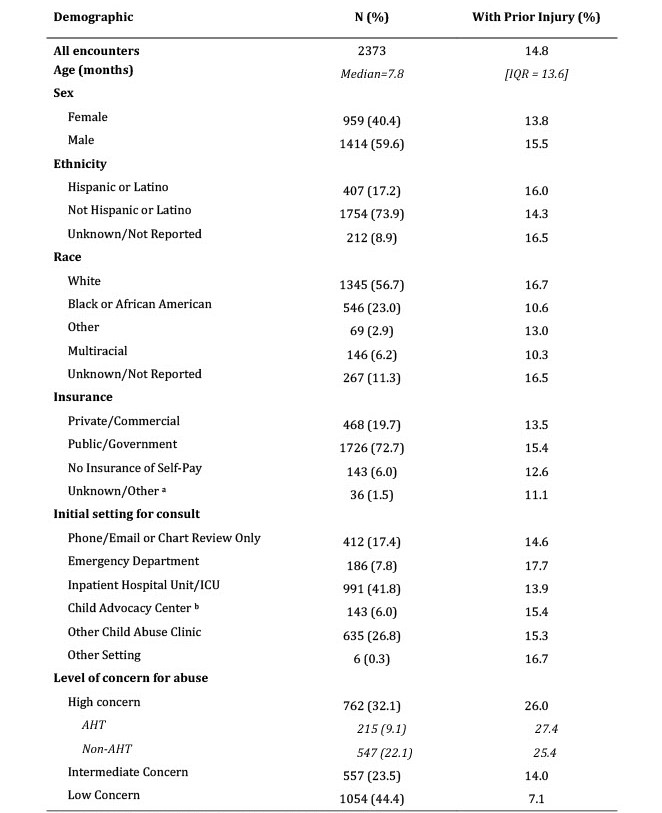Child Abuse & Neglect
Child Abuse & Neglect 2
611 - The Prevalence and Types of Prior Injuries Seen in Young Children Diagnosed with Physical Abuse
Friday, April 28, 2023
5:15 PM - 7:15 PM ET
Poster Number: 611
Publication Number: 611.104
Publication Number: 611.104
Nara Cho, Nationwide Children's Hospital, Columbus, OH, United States; Kristin G. Crichton, Nationwide Children's Hospital, Columbus, OH, United States; Megan M.. Letson, Nationwide Children's Hospital, Columbus, OH, United States; Sara Helwig, Nationwide Children's Hospital, Columbus, OH, United States; Krista Wheeler, Nationwide Children's Hospital, Columbus, OH, United States; Rachel Stanley, Nationwide Children's Hospital, Columbus, OH, United States; Kristine A. Campbell, University of Utah, Salt Lake City, UT, United States; Farah W. Brink, Ohio, Columbus, OH, United States

Nara Cho, MD (she/her/hers)
Child Abuse Fellow
Nationwide Children's Hospital
Columbus, Ohio, United States
Presenting Author(s)
Background: Child physical abuse (PA) is a leading cause of morbidity and mortality. Understanding prevalence and types of prior injuries in young children evaluated for PA may improve early recognition and appropriate evaluation, thus preventing recurrent PA.
Objective: 1. Compare prevalence of prior injuries in the following three groups of children (0-36 months) who were evaluated for PA: high, intermediate, and low concern for PA.
2. Describe types of prior injuries in each group and evaluate whether a medical provider was aware of at least one injury.
Design/Methods: We retrospectively identified encounters in children ages 0-36 months using data from the Child Abuse Pediatrics Network (CAPNET) from February 2021 to January 2022. Encounters in which prior injury history was unknown/not assessed were excluded. The remaining encounters were then divided into three groups based on the validated PA likelihood rating assigned by a child abuse pediatrician at the time of evaluation: high, intermediate, and low concern for PA. We compared prevalence and types of prior injuries in these groups. Sub-analysis of those diagnosed with abusive head trauma (AHT) was completed. Fisher's exact tests and multiple logistic regression analyses were performed.
Results: We identified 2373 eligible encounters (59.6% male, 56.7% white, median age: 7.8 months; 72.7% public insurance). A history of prior injury was more frequently reported in children with high concern for PA (26.0%), compared to those with low concern (7.10% [OR: 4.58, 95% CI: 3.42, 6.18]). There was no statistically significant difference in prevalence and types of prior injury between AHT and non-AHT groups. Patients with one or more types of prior injury were 3.7 times more likely to be in the next highest level of concern than those with no prior injury (AOR: 3.67, 95% CI: 2.86, 4.72) and 2.6 times more with each additional injury (AOR: 2.64, 95% CI: 2.19, 3.21). The most common type of prior injury was TEN-4-FACES bruising in those with high concern for PA, and non-skull fracture in those with low concern. Prior TEN-4-FACES bruising, other unusual bruising, and oral injury/bleeding were associated with increased odds of having a high level of concern for PA. Among those patient encounters with high concern for PA and prior injury, medical provider awareness of prior injuries was reported at 64.0%.
Conclusion(s): A history of prior injury is more frequently reported in children diagnosed with PA than those with low concern for PA.

.jpg)
.jpg)
